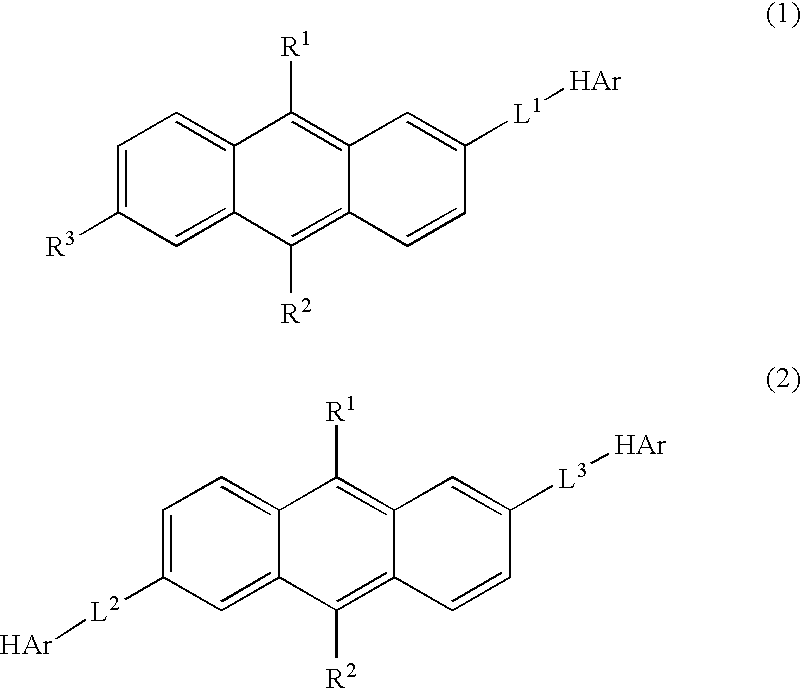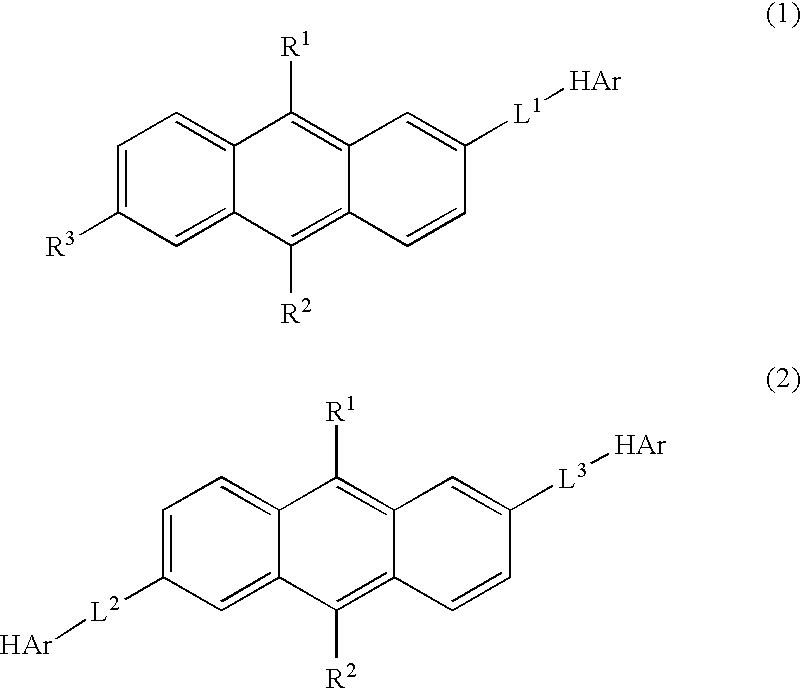Anthracene Derivative and Organic Electroluminescent Element Using the Same
an anthracene derivative and organic electroluminescent element technology, applied in the direction of luminescnet screens, group 5/15 element organic compounds, natural mineral layered products, etc., can solve the problems of short lifetime, low melting point, and observed formation of exclexes, and achieve the effect of long lifetim
- Summary
- Abstract
- Description
- Claims
- Application Information
AI Technical Summary
Benefits of technology
Problems solved by technology
Method used
Image
Examples
synthetic example 1
synthesis of 9,10-diphenyl-2-(6-phenylpyridine-2-yl)anthracene (compound 1)
[0104]A compound 1 shown below was synthesized by the following reaction process:
(1-a) Synthesis of 2-bromoanthraquinone
[0105]Copper bromide 18 g (81 mmol) and t-butyl nitrite 12 mL (101 mmol) were dispersed in acetonitrile of 65° C., and 15 g (67 mmol) of 2-aminoanthraquinone was dropwise added thereto while vigorously stirring. The solution was stirred until gas was not discharged and cooled down to room temperature, and 20% hydrochloric acid (1 L) was added thereto, followed by extracting the solution with dichloromethane. The organic layer was dried on magnesium sulfate, and the solvent was removed by distillation under reduced pressure. The residue was refined by silica gel chromatography to obtain 14 g (yield 75%) of 2-bromoanthraquinone.
(1-b) Synthesis of 2-bromo-9,10-diphenyl-9,9,10,10-tetrahydroanthracene-9,10-diol
[0106]Bromobenzene 5.4 mL (52 mmol) was dissolved in 100 mL of dehydrated tetrahydrofur...
synthetic example 2
synthesis of 9,0-diphenyl-2-(4,6-diphenylpyrimidine-2-yl)anthracene (compound 2)
[0112]A compound 2 shown below was synthesized by the following reaction process:
(2-a) Synthesis of 2-amino-4,6-diphenylpyrimidine
[0113]2-Amino-4,6-dichloropyrimidine 9.5 g (58 mmol), phenylboronic acid 17 g (140 mmol) and tetrakis(triphenylphosphine)palladium 2.7 g (2.3 mmol) were dissolved in 120 mL of 1,2-dimethoxyethane. A 2.0M sodium carbonate aqueous solution 60 mL was added thereto, and the solution was refluxed for 8 hours under argon atmosphere by heating. After finishing the reaction, the aqueous layer was removed. The organic layer was dried on anhydrous magnesium sulfate, and the solvent was removed by distillation under reduced pressure. The residue was refined by silica gel chromatography to obtain 11 g (yield: 77%) of 2-amino-4,6-diphenylpyrimidine.
(2-b) Synthesis of 2-bromo-4,6-diphenylpyrimidine
[0114]48% HBr 50 mL was added to 11 g (44 mmol) of 2-amino-4,6-diphenylpyrimidine and stirred....
synthetic example 3
synthesis of 9,10-diphenyl-2-(4,6-diphenyltriazine-2-yl)anthracene (compound 3)
[0116]A compound 3 shown below was synthesized by the following reaction step:
[0117]2-Chloro-4,6-diphenyl-1,3,5-triazine was synthesized by a publicly known synthetic process described in Japanese Patent No. 3067878. 2-Chloro-4,6-diphenyl-1,3,5-triazine 2.9 g (11 mmol), 9,10-diphenylanthracene-2-boronic acid 4.9 g (13 mmol) and tetrakis(triphenylphosphine)palladium 0.25 g (0.22 mmol) were dissolved in 60 mL of 1,2-dimethoxyethane. A 2.0M sodium carbonate aqueous solution 30 mL was added thereto, and the solution was refluxed for 8 hours under argon atmosphere by heating. After finishing the reaction, the solution was filtered, and a solid matter obtained was washed with water, methanol and toluene to obtain 5.3 g (yield: 86%) of a greenish white solid matter. Mass spectral analysis of the above solid matter resulted in confirming that m / e was 560 versus a molecular weight of 560.23 and that it was the aim...
PUM
 Login to View More
Login to View More Abstract
Description
Claims
Application Information
 Login to View More
Login to View More - R&D
- Intellectual Property
- Life Sciences
- Materials
- Tech Scout
- Unparalleled Data Quality
- Higher Quality Content
- 60% Fewer Hallucinations
Browse by: Latest US Patents, China's latest patents, Technical Efficacy Thesaurus, Application Domain, Technology Topic, Popular Technical Reports.
© 2025 PatSnap. All rights reserved.Legal|Privacy policy|Modern Slavery Act Transparency Statement|Sitemap|About US| Contact US: help@patsnap.com



